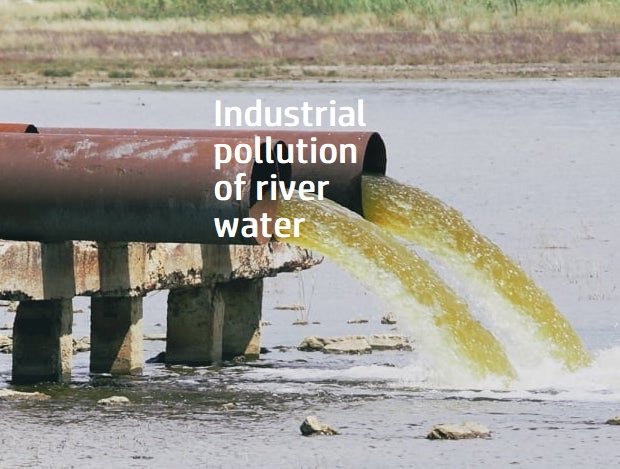Environment & Ecology, UPSC
Q.7. Industrial pollution of river water is a significant environmental issue in India. Discuss the various mitigation measures to deal with this problem and also the government’s initiatives in this regard. [UPSC 2024 GS P-3]
Industrial pollution of river water is a critical environmental issue in India, primarily caused by the discharge of untreated or inadequately treated wastewater from industries such as textiles, chemicals, pharmaceuticals, paper, and tanneries into rivers. This contamination affects water quality, harms aquatic ecosystems, and poses significant health risks to humans who rely on these rivers for drinking water, agriculture, and livelihood.
Mitigation Measures to Deal with Industrial Pollution of River Water
- Strict Enforcement of Pollution Control Laws:
- Regulatory frameworks such as the Water (Prevention and Control of Pollution) Act, 1974 and the Environment Protection Act, 1986 already exist, but stricter enforcement is required. Industries must be held accountable for ensuring that their effluents meet the standards set by the Central Pollution Control Board (CPCB) and State Pollution Control Boards (SPCBs).
- Treatment of Industrial Wastewater:
- Effluent Treatment Plants (ETPs): Industries should be required to set up and operate ETPs to treat wastewater before releasing it into rivers. Advanced treatment technologies such as Reverse Osmosis (RO), Membrane Bioreactors (MBRs), and Zero Liquid Discharge (ZLD) systems should be encouraged.
- Common Effluent Treatment Plants (CETPs): Small and medium industries can collaborate to set up CETPs, which are more cost-effective and ensure compliance with pollution control norms.
- Reduction of Pollutants at Source:
- Promoting cleaner production technologies and resource efficiency can help industries minimize waste generation at the source. For instance, industries can adopt closed-loop systems, recycle process water, and use green chemistry to reduce harmful byproducts.
- Substituting hazardous chemicals with eco-friendly alternatives reduces the pollutant load in wastewater.
- Pollution Monitoring and Real-Time Surveillance:
- The government can mandate the installation of real-time monitoring systems at industrial effluent discharge points. These systems will allow authorities to track pollution levels continuously and take immediate action if standards are violated.
- CPCB’s Online Continuous Effluent Monitoring System (OCEMS) is already in place to ensure that industries comply with wastewater discharge norms.
- Public-Private Partnerships (PPPs):
- Encouraging Public-Private Partnerships can help in the development of pollution control technologies, the setting up of common treatment plants, and the maintenance of pollution monitoring systems. Industries and the government can work together to invest in sustainable infrastructure.
- Wastewater Recycling and Reuse:
- Industries should be incentivized to recycle and reuse wastewater, particularly in water-scarce regions. Recycled water can be used for industrial processes, landscaping, or even agriculture, reducing the demand for freshwater and limiting effluent discharge.
- Public Awareness and Corporate Responsibility:
- Corporate Social Responsibility (CSR) initiatives can play a role in environmental conservation. Industries can be encouraged to fund projects aimed at river restoration and pollution abatement.
- Public awareness campaigns can also encourage industries to adopt sustainable practices and comply with environmental regulations.
- Banning Hazardous Substances:
- Some industrial pollutants, such as heavy metals and toxic chemicals, can cause long-term damage to water bodies. The government can enforce bans or restrictions on the use of particularly hazardous substances.
Government Initiatives to Address Industrial River Pollution
- National River Conservation Plan (NRCP):
- The NRCP aims to improve water quality in major rivers by implementing pollution abatement measures, including sewage treatment plants (STPs), ETPs, and the regulation of industrial effluents.
- The program focuses on pollution reduction in critically polluted river stretches through various government interventions.
- Namami Gange Programme:
- Launched in 2014, the Namami Gange Programme is an integrated initiative aimed at cleaning and rejuvenating the Ganga River. It involves setting up sewage treatment infrastructure, improving industrial wastewater management, and promoting riverfront development.
- The program includes the enforcement of stricter discharge standards for industries located in the Ganga basin and the establishment of Common Effluent Treatment Plants (CETPs).
- National Mission for Clean Ganga (NMCG):
- Under the NMCG, industrial pollution control is a key component. Industries located along the Ganga are required to install Effluent Treatment Plants (ETPs) and ensure zero liquid discharge.
- The mission also emphasizes real-time monitoring of industrial effluents, making sure that industries comply with environmental norms.
- National Green Tribunal (NGT):
- The NGT plays a significant role in enforcing environmental laws. It has passed numerous orders to stop illegal discharge of industrial effluents into rivers and imposed penalties on non-compliant industries. For instance, the NGT has taken strong action in cases of pollution in the Yamuna and Ganga rivers.
- Pollution Abatement Programmes:
- The Pollution Abatement Programme under the Ministry of Environment, Forest and Climate Change (MoEFCC) aims at preventing and controlling pollution in rivers through various strategies, including effluent control and the installation of treatment plants.
- Smart Industrial Clusters:
- The government has proposed the creation of smart industrial clusters where industries are co-located in a way that facilitates shared resources such as common effluent treatment plants (CETPs) and promotes the use of clean technologies.
- Cleaner Production Initiatives:
- Various initiatives such as ZED (Zero Effect, Zero Defect) and National Action Plan for Climate Change encourage industries to adopt cleaner production techniques and reduce their environmental footprint.
- Water Pollution Prevention and Control Measures:
- The Water (Prevention and Control of Pollution) Cess Act, 1977 imposes a tax on water consumption by industries, encouraging them to optimize water use and reduce pollution.
Conclusion
Industrial pollution of rivers is a significant challenge in India, affecting both the environment and public health. Mitigating this issue requires a multi-pronged approach, including the strict enforcement of pollution control laws, the use of advanced wastewater treatment technologies, reduction of pollutants at the source, and increased collaboration between industries and the government. Initiatives such as Namami Gange and the National River Conservation Plan are important steps in the right direction, but long-term success will depend on sustained efforts, technological innovation, and public accountability.


